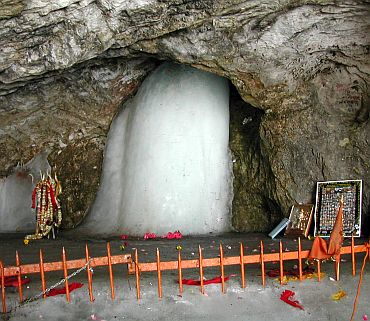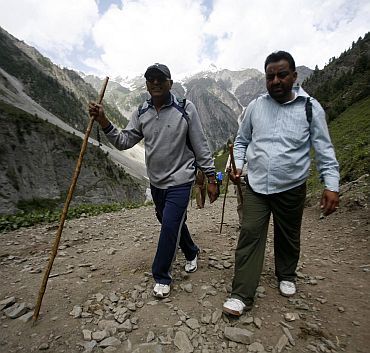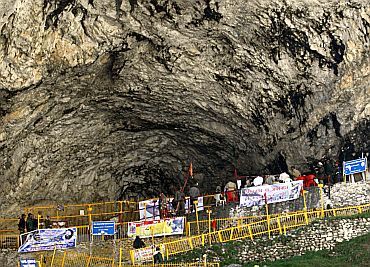

The holy cave of Amarnath is situated in the Himalyan range surrounded by snow-capped mountains, about 96 kilometres from Srinagar with the base camp at the picturesque tourist resort of Pahalgam.
A huge-tented township comes up here during the Yatra to accommodate the pilgrims.
The distance from Pahalgam to the cave is 46 kilometres. The pilgrimage from this traditional route takes four days with overnight stops at Chandanwari, Sheshnag and Panchtarni.

Beyond Chandanwari -- 3 kilometres from Pahalgam -- it is a foot-march with the elderly persons moving on horsebacks and the sick and disabled being carried on palanquins, chanting 'Baba Amarnath ki Jai'.
The highest point touched en-route is the Mahaguns, which is about 14,500 feet above the sea level. The cave itself is at a lower elevation of about 1,300 feet.
There is shorter route as well -- the Baltal route. It is just 14 kilometres to the cave but its topography makes it risky in case of bad weather.
Quite a few pilgrims take this route to save on time. A helicopter service from Pahalgam to Panchtarni is also in place.

Officially, the yatra is organised by the state government in collaboration with the Shree Amarnath Yatra trust.
The government agencies provide necessary facilities all along the route during the yatra period, which includes provision of ponies, supply of power, telecommunication facilities, firewood and setting up of fair price shops.
A number of voluntary organisations from across the country join the efforts by setting up pandals to provide eatables and other necessities to the pilgrims all along the route.

There are a number of versions about the importance of the pilgrimage. The most popular version is that it was in this cave that Lord Shiva revealed the secrets of immortality to his consort Parvati.
Two pigeons who overheard the conversation achieved immortality and appear briefly at the cave on the Shravana Poornima day, even to this day.
One is amazed to see the pair of pigeons surviving in a climate where no birds are ever seen. Inside the cave a natural ice lingam is formed during the Shravana Poornima to represent Lord Shiva, which waxes and wanes according to the cycle of the moon.
Two other ice formations are also there which represent Parvati and Ganesh. There is a mention of the cave in the puranas as well.


The pilgrimage has been of particular importance for the people of Kashmir. It has deepened the bonds of brotherhood among the Hindus and Muslims living in the valley for ages.
Though it is a Hindu pilgrimage, Muslims have been providing necessary services to the pilgrims, in keeping with the rich secular traditions of the place. These include provision of ponies and Pithoos (palanquins for carrying the old and the sick).
Despite the militant attack at Pahalgam in 2006, there has been no let up in the Yatra. In fact the number of yatris has been ever growing. The pilgrimage stands out as a symbol of Hindu Muslim unity in the Valley